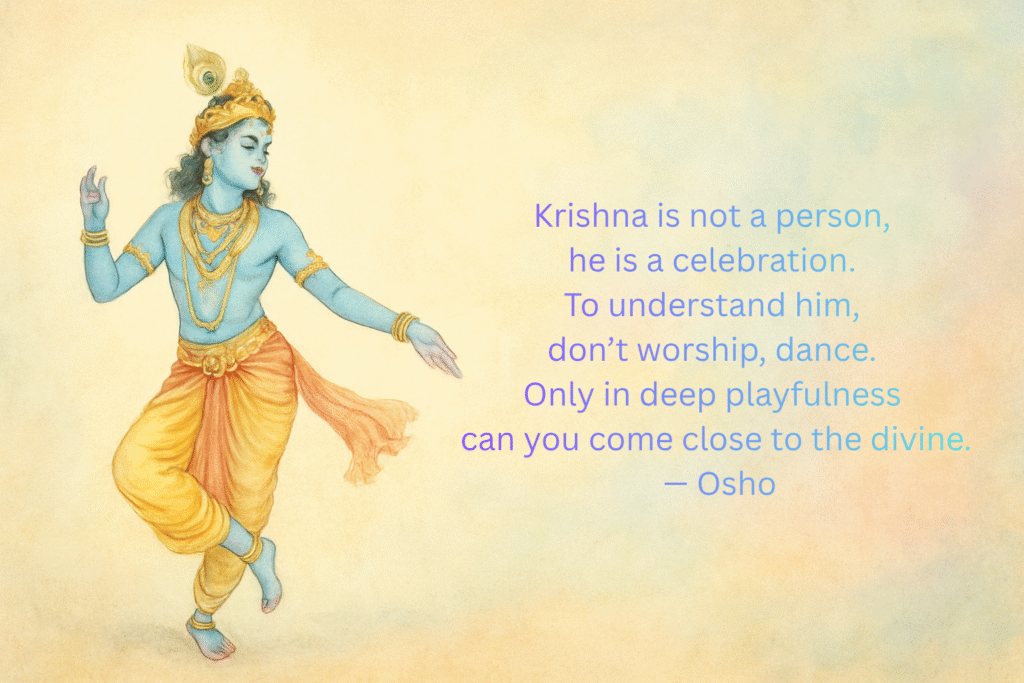Osho on Krishna: The Man, The Mystic, The Future of Spirituality
Krishna, perhaps the most popular and mysterious figure of Indian spirituality, holds a prime position in spiritual literature, mythology, and devotional practice. However, the way Osho have understood Krishna’s life , hardly any other so called philosophers have understood ,and in doing so Osho have perceived him not only as a mythic or historical figure but as the living personification of a new spiritual awareness, a man of the future.
Osho’s vision, presented in a series of talks brought together in ‘Krishna: The Man and His Philosophy’, Through his talks, Osho breaks away from traditional religious views and invites us to see Krishna as a symbol of total acceptance of life. This blog explores Osho’s vision of him not as a myth or even as a god, but as a joyful human being, a complete celebration of life itself.
Krishna as the Whole and Complete Man
Osho starts by underlining Krishna’s wholeness and completeness. While most spiritual leaders give up life or live in despair, he is described as being essentially full of life, joyful, and accepting. Osho states:
“Krishna is called whole because this man is absolutely empty. And only he who is choiceless can be empty.”
To be “choiceless” in this sense is to take everything that life has in offer both light and darkness, both good and bad without fragmentation or denial. He is not trying to escape from the world as illusion; he is embracing it as real and divine. This attitude is in stark contrast to the teachings of other religious gurus, who see the world as something to leave behind.
Osho argues that the true path, as embodied by Krishna, lies in choiceless acceptance, where one does not pick and choose parts of reality but embraces the whole. This totality is what makes him unique and complete, a symbol of unity in a dualistic world.
The Future of Spirituality: Beyond Duality
To Osho, he is not merely a character of ancient legend; he is a messenger of the future. Osho recognizes his teaching as being deeply ahead of its time, appropriate for a new era in which humanity will come to appreciate his harmony of opposites.
His philosophy instructs us that good and bad, light and darkness, non-violence and violence all exist side by side and characterize each other. To reject one pole is bound to be tensive because the rejected pole still exists. Only through embracing the co-existence of these poles can one transcend choosing:
“Krishna says, ‘Accept both the polarities, because both are there together… Don’t choose!’
This philosophy of choicelessness provides a means to go beyond conflict, beyond the hard morality that separates life into good and bad. Osho’s Krishna thereby sets the stage for an emerging spirituality that accepts ambiguity, complexity, and paradox as necessary.
Krishna the Loving Rebel
Osho points to his playful defiance of stern religious orthodoxy and moralism. In contrast to stern ascetics or stern saints, he is shown laughing, dancing, and enjoying life with unbridled mirth. His spirituality is not that of weeping renunciation but of rapturous freedom and discovery:
“He is not serious and sad, not in tears… In the long line of such sages it is Krishna alone who comes dancing, singing and laughing.”
Osho compares his joyful sannyas to other spiritual masters such as Buddha or Mahavira, who underwent ascetic practice and spiritual struggle before they achieved peace. He, on the contrary, is a siddha an accomplished individual who is enlightened without such a sadhana (spiritual effort).
This difference mirrors Osho’s general philosophy of embracing life in full awareness. Krishna’s ability to love, dance, fight, and play is not separable from his spiritual awakening, a complete wholeness free from repression.
Krishna as the Teacher of Choiceless Awareness
At the heart of Osho’s understanding is Krishna’s instruction on choiceless awareness (nirvichar). This instruction invites witnessing life without judgment or trying to control the outcome. On the Bhagavad Gita, Krishna instructs Arjuna not to be the doer but a witness to the actions happening, acting without attachment to the result.
Osho explains it as a revolutionary freedom from moralistic conditioning:
“Krishna says: Look at the entire situation, and don’t obey dead moralists’ rules. Look at the situation and be a witness; don’t be a doer.”
This witnessing awareness liberates one from warfare, grief, and duality, so that life can be lived in its fullness and with compassion unencumbered by the ego’s desires or fears.
Krishna’s Integration of Love and Combat
One of Krishna’s strongest paradoxes is that he is at once full of love and violent. Osho emphasizes that his love is boundless, but he will use his weapon, the Sudarshan Chakra without remorse if he needs to. He is both a sannyasin who loves the universe a lot and a warrior dedicated to aggressive action:
“His love is boundless, but he will not hesitate to kill if that is necessary… He is dedicated to the entire. He is complete.”
This warrior-of-love position embodies the synthesis of polarity themes holding both compassion and strength without contradiction. Osho views this as a pattern for an emerging spiritual being: one who neither withdraws from the world nor divorces himself from righteousness.
The Cosmic Play and Beyond
Osho tends to ponder Krishna’s part in the cosmic play or lila, a sacred drama wherein the universe unrolls. Krishna’s life from his boyhood mischief to his part in the Mahabharata is a dance that goes beyond finite human comprehension:
“It is impossible to put Krishna into logical pigeonholes because he will not accept your logic he is the huge ocean that he is.”
He transcends fixed definitions, experiencing an omnipresent awareness that perpetually undermines settled concepts. To approach his tale is, for Osho, to be invited to dispel narrow identities and become one with cosmic awareness.
Krishna and Meditation
While other masters of spirituality emphasized harsh austerities, fasting, or yogic discipline, his existence as described by Osho was unencumbered by such strife. His awakening was unpremeditated, and unchanging:
“Did you ever hear that Krishna underwent any kind of spiritual discipline? Did he practice meditation? Did he practice yoga? Did he fast? Did he renounce the world? No.”
This is the nature which makes him a paradigm of joyful, effortless divinity. For seekers, Osho implies, emulating his way means transcendence from self-caused misery to a state of joyous, natural existence.

Osho’s Devotion to Krishna’s Philosophy
Osho’s own teachings echo Krishna’s core themes: living paradox, joyful living, moving beyond duality, and developing choiceless awareness. From his many talks and writings, Osho repeatedly returned to Krishna as a template for a new spiritual human a human who brings the worldly and the divine together without contradiction.
In celebration of Krishna’s intelligence, Osho calls to us to see the sacred in the wholeness of life. By melting within narrow moralities and partial truths, we can become aware of Krishna’s wholeness and savor life as a shining dance.
Conclusion
For Osho, he is not a remote figure of the past but a deep message for human consciousness in the future. The philosophy of choiceless acceptance, joyful freedom, and cosmic integration of Krishna shatters tradition and demands a new spirituality based on love, balance, and awareness beyond duality.
Osho’s insightful translation creates a window to return to Krishna not as a character trapped in scripture but as a living master to embracing life in all its colors light and darkness, joy and grief, love and battle. By this return, Krishna is revealed as an authentic master of inner completeness a beacon for those who would live authentically and meditate profoundly in today’s world.
Want to know about our upcoming camps? Just contact us, we’re here to help.
